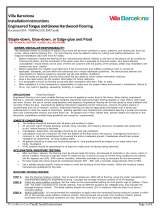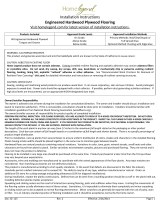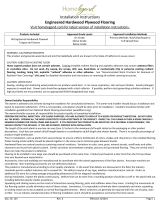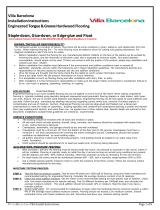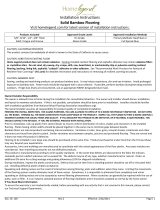Page is loading ...

www.eastcoastrustic.com
Questions? [email protected]
ABOUT EAST COAST RUSTIC PRODUCTS
All of our wood is sourced from very old barns and carefully dismantled by our crews. The wood is primarily “old
growth” Hemlock. It is brought to our shop and then goes through a drying . Once it reaches the proper dryness; it
is de-nailed, cleaned, machined and packaged all ready to ship.
SAFETY
You should always follow proper safe work practices and wear safety glasses and a dust mask when cutting wood.
Follow all prescribed safety practices when working with power tools.
TOOLS
Mandatory Tools: Optional Tools:
- Pencil - Jig Saw
- Tape measure - Air Nailer
- Saw - Table Saw
- Caulking gun - Stud Finder
- Hammer
- Utility knife
- Shop-vac
ACCLIMATIZING
When you receive your wood, place the boxes in the room you will be installing them. Open the boxes, either at
the top of large boxes or at both ends of the small boxes. No need to remove the wood. Let them breath for 48
hours like that to adjust to your room before installing.
INSTALLER/OWNER RESPONSIBILITY
It is the responsibility of the installer and owner to ensure that the wood is installed as per the instructions. East
Coast Rustic takes no responsibility for wood that was not acclimatized prior to installation. Acclimation allows
wood to adjust to the environment in which it’s installed. Expansion and contraction will be minimized if climate
control is consistently maintained.
SPECIAL NOTE FOR GREY BOARDS
Our weathered grey boards are unfinished. *NOTE: If you choose to seal the GREY wood, we strongly suggest you
try a few small sample pieces first, as all sealers will darken them considerably.
INSTALLATION INSTRUCTIONS
BEFORE YOU START
WALL PREPERATION:
It is important that the wall or surface you are covering is clean, dry, and as smooth as possible. We strongly
recommend that before you start installing the boards you give the backs a good cleaning with the shop-vac to
remove any dirt or sawdust that may be present as that will hinder glue adhesion. Heavily textured walls should be
made relatively smooth with a scrapper or with coarse sandpaper. New drywall should be finished and primed. If
going over wallpaper, remove any loose paper and prime bare areas. Remove any loose or flaking paint. Remove
any protrusions like picture hangers, nails etc. Remove temporarily any electrical cover plates.
INSTALLATION:
We recommend using a quality construction adhesive and nails for best results.
It is a good practice here to locate and mark vertically the location of framing studs behind the drywall for nailing.
1) Remove all the wood from the boxes. You will find a variety of lengths, colors and textures. Do a basic sort
of lengths and colors to help with your wall layout. Mixing up lengths, colors etc will give you a more
random effect. Decide what to do with boards that are “not your favourite” either put them in an
inconspicuous area, near the floor, behind tv, etc, or hopefully you have ordered some extra and won’t
need them. Some boards will have splits and knot holes. You may want to just cut out the holes. Handle
the split ones with care. They will be fine once glued to the wall.
2) If you are going around a corner run the boards right to the edge and then cover the corner with our
matching outside corner trim pieces. Refer to Figure A

www.eastcoastrustic.com
Questions? [email protected]
Figure A - Cut tip of glue tube off to give you a ¼” opening.
Figure B - If you are stopping on the flat wall leave a 1/2” space and cover the edges with our flat wall trim pieces.
Figure C - Depending on the board width, apply adhesive as in and place the first row on lightly.
3) We suggest you start from the bottom and work your way up, cutting the last top row to suit. Make sure
the bottom row is straight. It will make subsequent rows easier to install.
4) Install the second row above, lightly. Now you can adjust these rows to align them straight, then push
them tight on the wall, and add a few nails to keep them in place.
5) Install successive rows by placing each board on wall giving a slight twisting motion as you push it firmly to
the wall. This will distribute the adhesive for better contact. Some boards may need a nail or two to help
hold them tight to wall. Push side to side ½ inch and Push Up and down ½ inch.
HINT FOR ELECTRICAL OUTLETS
1) Locate circuit breaker or fuse and turn power off to the plug or switch.
2) Loosen the screws that hold the device to the wall, enough for the wood to slide under the device.
3) Use a jig saw to cut a notch to fit the screw and then apply board to wall. Refer to Figure D
4) Re-tighten screws. In some cases, you may need to replace the screw with a longer one. Usually available
from any hardware store.
Figure D
/
